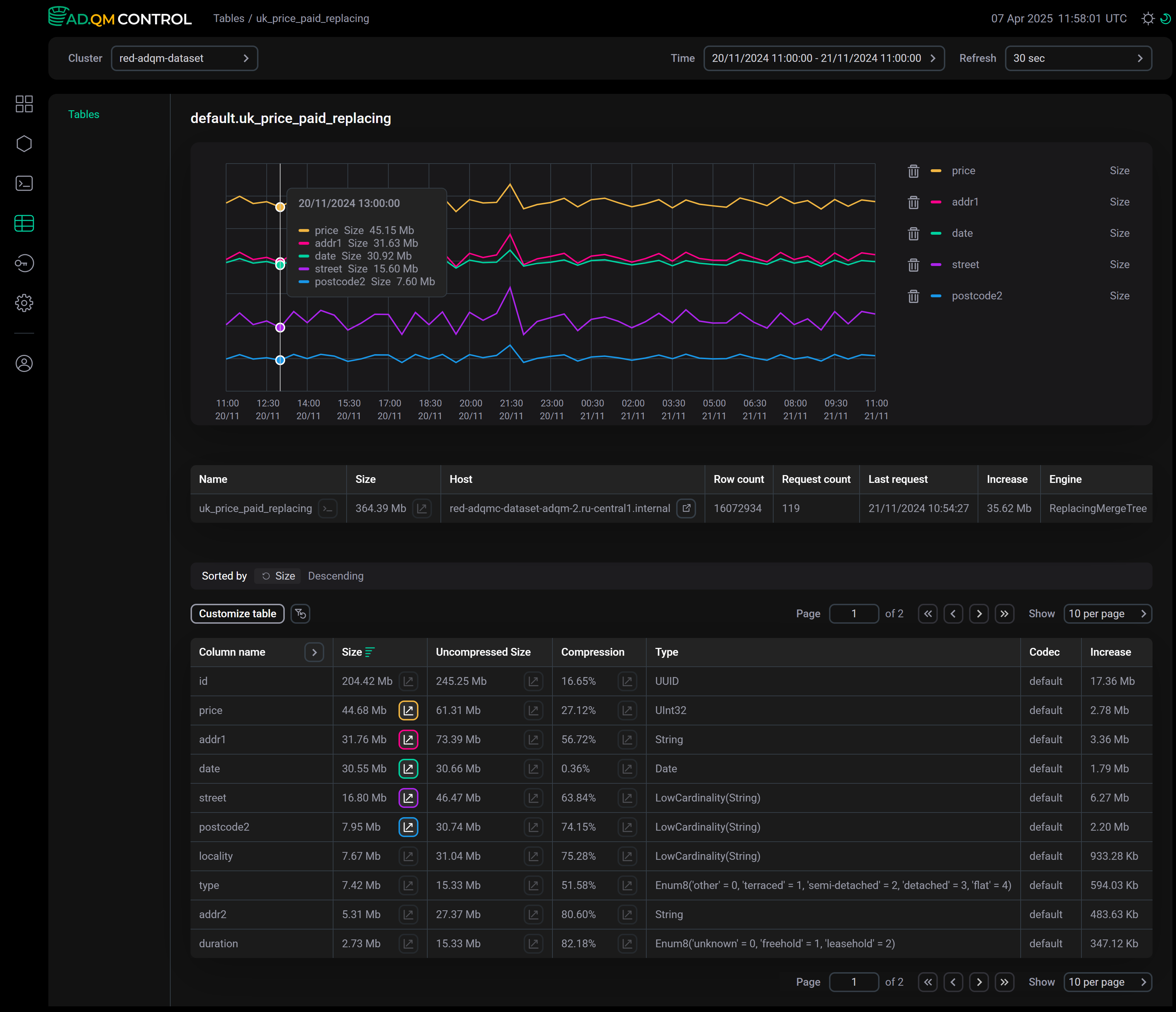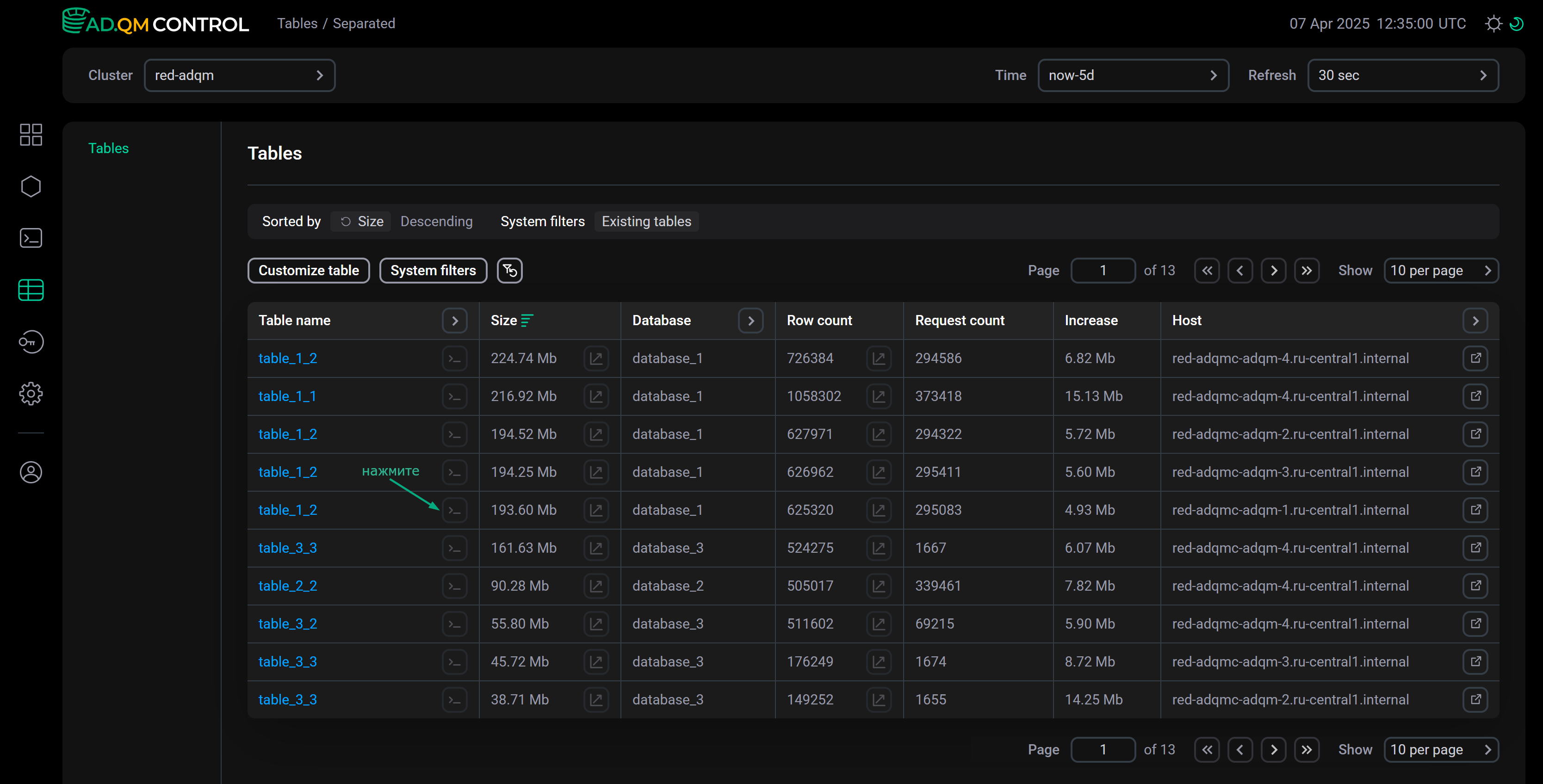

Work with tables in ADQM Control
The Tables page of the ADQM Control web interface displays information about data tables in an ADQM cluster connected to the monitoring system. On this page, you can view a list of all cluster tables with general information about them, switch to details on columns of an individual table, and also visually identify changes in sizes of tables using graphs.

At the top of the screen, you can set up the following filters to select which data the Tables page should display:
-
Cluster — ADQM cluster where data tables are located.
-
Time — time period for which information about tables should be displayed. In the window that opens when you click the field, you can select an interval from the offered options on the Range tab or set a custom time range (at least 1 hour) on the Calendar tab.
-
Refresh — frequency of data updates.
List of tables
The Tables page lists data tables of an ADQM cluster as a table with the following fields.
| Field | Description |
|---|---|
Table name |
Name of an ADQM table |
Size |
Size of compressed data in a table at the end of the selected time interval |
Database |
Database to which a table belongs |
It is also possible to add more fields with additional information on ADQM tables — to do this, click Customize table and select the required fields in the drop-down list.

| Field | Description |
|---|---|
Row count |
Number of data rows in a table at the end of the selected time interval |
Request count |
Number of queries sent to a table during the selected time interval |
Last request |
Time the last query to a table was run during the selected time interval |
Increase |
Change in a table size over the selected time interval (a negative value means a decrease in the amount of data in the table) |
Host |
ADQM cluster host where a table is located. Clicking on the icon |
Engine |
Table engine |
Graphs
On the Tables page, you can get graphs to track the dynamics of changes in the Size and Row count metrics of ADQM tables (size of compressed data on disk and number of rows, respectively) over a selected period of time.
Click the icon
in the column of the corresponding metric — above the list of tables, ADQM Control will display a section with a graph built based on this metric of the ADQM table. You can add up to 8 graphs (inclusive) simultaneously.
To see values of metrics at some point in time, hover the mouse over the graph area.

To delete a graph, click the icon corresponding to the graph color in the table (for example,
and
in the image above) or the icon
in the legend to the right of the graphs.
Filter and sort data
In the Table name, Database, Host, and Engine column headers, there are filters that you can use to select the necessary data on the Tables page. To set a filter, click the icon
and enter a value you are looking for (a table/database/engine name or its part, or full names of hosts). The icon
means that a filter is defined for the column. To reset all filters by columns, click
.
Clicking on System filters opens a list of predefined filters that you can activate with the switch
:
-
Show system.tables — display ADQM system tables from the
systemdatabase; -
Only existing tables — display only tables that exist in the cluster at the last point of the specified time interval (tables for which ADQM Control received metrics at the end of this time period);
-
Only tables with graph — display only the tables based on which graphs are currently plotted.
It is also possible to sort data on the Tables page by values in any column of the table with the list of ADQM tables. To apply sorting by a column, click the icon
or
in its header.
Above the list of tables, there is a panel that shows the sorting (Sorted by) and filtering (System filters, Filtered by) conditions currently applied to data.

You can also view the list of the largest tables by data amount or the list of the most frequently queried tables in the ADQM cluster in the Top 10 tables section on the Dashboard page.
Table details
To open a separate page with detailed information about an ADQM table, click a table name in the Table name column.

At the top of the page that opens, there is information about the ADQM table: name, size of compressed data, host, number of rows, number of queries sent to the table, time of the last query, data size change, and engine.
This page also displays a table with the following fields that contain detailed information about each column of the selected ADQM table (to control the visibility of some fields, use the Customize table option).
| Field | Description |
|---|---|
Column name |
Column name at the end of the selected time interval |
Size |
Size of column data in compressed form |
Uncompressed Size |
Size of column data in uncompressed form |
Compression |
Percent of disk space saved by data compression |
Type |
Column data type |
Codec |
Data compression codecs applied to a column |
Comment |
Comment for a column |
Increase |
Change in size of column data over the selected time interval |

You can filter data in this table by the Column name field (to set a filter, click
in the column header) and sort by any column except Comment (use the icons
and
in column headers).
On this page, you can also build graphs to see how the size of compressed or uncompressed data in individual columns of an ADQM table changes over the selected time interval, or to analyze effect of applying data compression on the amount of disk space saved. To do this, use the icon
in the Size, Uncompressed Size, or Compression column, respectively. The graph area can display up to 7 graphs by individual columns and one graph by the entire table size at a time.


|
CAUTION
In the following cases, graph lines may be interrupted, which can lead to an inaccurate representation of column states and confuse users:
The rendering of graphs for such cases will be fixed in future releases of ADQM Control. |
Related queries
From the Tables page (as well as from the page with ADQM table details), you can access the list of queries sent to a specific ADQM table for a selected time interval. To do this, click the icon
in the Table name cell corresponding to the desired data table — this opens the Queries page with automatically configured filters by table name, database, and host.
